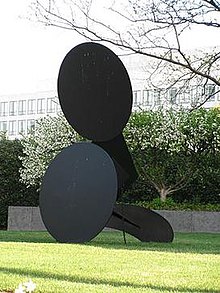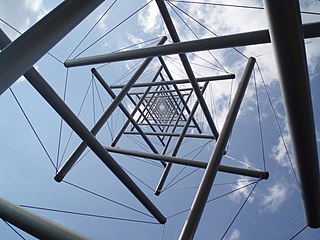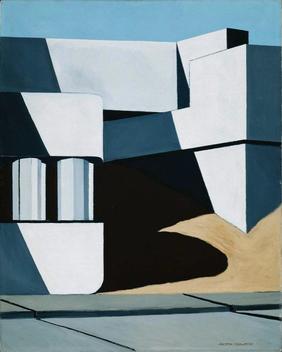
Geometric Mouse, Variation I, Scale A is an abstract sculpture by Claes Oldenburg. created in 1971. [1]
Examples are located at the Hirshhorn Museum and Sculpture Garden, [2] Museum of Modern Art, [3] and Walker Art Center. [4] [5]

Geometric Mouse, Variation I, Scale A is an abstract sculpture by Claes Oldenburg. created in 1971. [1]
Examples are located at the Hirshhorn Museum and Sculpture Garden, [2] Museum of Modern Art, [3] and Walker Art Center. [4] [5]

The Hirshhorn Museum and Sculpture Garden is an art museum beside the National Mall in Washington, D.C., United States. The museum was initially endowed during the 1960s with the permanent art collection of Joseph H. Hirshhorn. It was designed by architect Gordon Bunshaft and is part of the Smithsonian Institution. It was conceived as the United States' museum of contemporary and modern art and currently focuses its collection-building and exhibition-planning mainly on the post–World War II period, with particular emphasis on art made during the last 50 years.

Kenneth Duane Snelson was an American contemporary sculptor and photographer. His sculptural works are composed of flexible and rigid components arranged according to the idea of 'tensegrity'. Snelson preferred the descriptive term floating compression.

The Minneapolis Sculpture Garden is an 11-acre (4.5 ha) park in Minneapolis, Minnesota, in the United States. It is located near the Walker Art Center, which operates it in coordination with the Minneapolis Park and Recreation Board. It reopened June 10, 2017 after a reconstruction that resulted with the Walker and Sculpture Garden being unified as one 19-acre campus. It is one of the largest urban sculpture gardens in the country, with 40 permanent art installations and several other temporary pieces that are moved in and out periodically.

The history of sculpture in the United States begins in the 1600s "with the modest efforts of craftsmen who adorned gravestones, Bible boxes, and various utilitarian objects with simple low-relief decorations." American sculpture in its many forms, genres and guises has continuously contributed to the cultural landscape of world art into the 21st century.

Sam Gilliam was an American color field painter and lyrical abstractionist artist. Gilliam was associated with the Washington Color School, a group of Washington, D.C.-area artists that developed a form of abstract art from color field painting in the 1950s and 1960s. His works have also been described as belonging to abstract expressionism and lyrical abstraction. He worked on stretched, draped and wrapped canvas, and added sculptural 3D elements. He was recognized as the first artist to introduce the idea of a draped, painted canvas hanging without stretcher bars around 1965. This was a major contribution to the Color Field School and has had a lasting impact on the contemporary art canon. Arne Glimcher, Gilliam's art dealer at Pace Gallery, wrote following his death that "His experiments with color and surface are right up there with the achievements of Rothko and Pollock."

Robert Engman was an American sculptor with works in the permanent collection of the Hirshhorn Museum, MOMA, the Whitney Museum of American Art, numerous college museums, and private collections.

Ralston Crawford (1906–1978) was an American abstract painter, lithographer, and photographer.

Irene Rice Pereira was an American abstract artist, poet and philosopher who played a major role in the development of modernism in the United States. She is known for her work in the genres of geometric abstraction, abstract expressionism and lyrical abstraction, as well as her use of the principles of the Bauhaus school. Her paintings and writings were significantly influenced by the complex intellectual currents of the 20th century.

Chryssa Vardea-Mavromichali was a Greek American artist who worked in a wide variety of media. An American art pioneer in light art and luminist sculpture, known for her neon, steel, aluminum and acrylic glass installations, she always used the mononym Chryssa professionally. She worked from the mid-1950s in New York City studios and worked since 1992 in the studio she established in Neos Kosmos, Athens, Greece.
Peter Forakis was an American artist and professor. He was known as an abstract geometric sculptor.

Claes Oldenburg was a Swedish-born American sculptor best known for his public art installations, typically featuring large replicas of everyday objects. Another theme in his work is soft sculpture versions of everyday objects. Many of his works were made in collaboration with his wife, Coosje van Bruggen, who died in 2009; they had been married for 32 years. Oldenburg lived and worked in New York City.
Tim Rollins was an American artist who together with the art collaborative K.O.S. formed the art-group Tim Rollins and K.O.S.

Aurora is a public artwork by American artist Mark di Suvero. It is in the collection of the National Gallery of Art and on display at the National Gallery of Art Sculpture Garden in Washington, D.C., United States.
Typewriter Eraser, Scale X is a sculpture of a large-scale typewriter eraser by Claes Oldenburg and Coosje van Bruggen.

Sky Hooks is a painted sheet steel sculpture by Alexander Calder, constructed in 1962. It is located at the Hirshhorn Museum and Sculpture Garden.

Eros, Inside Eros (1986) is a bronze sculpture by Arman.

Lunar Bird is an abstract bronze sculpture by Joan Miró. It was modeled in 1945, enlarged in 1966, and cast in 1967.
Clamdigger is a bronze sculpture by Willem de Kooning. It may have been inspired by "the men who dug for clams along the beaches" near his home in East Hampton, New York. It has been described as one of his "extraordinarily tactile figurative sculptures" that "seemed pulled from the primordial ooze," and "as part man, part creature of the mud and the shallows."

Modern sculpture is generally considered to have begun with the work of Auguste Rodin, who is seen as the progenitor of modern sculpture. While Rodin did not set out to rebel against the past, he created a new way of building his works. He "dissolved the hard outline of contemporary Neo-Greek academicism, and thereby created a vital synthesis of opacity and transparency, volume and void". Along with a few other artists in the late 19th century who experimented with new artistic visions in sculpture like Edgar Degas and Paul Gauguin, Rodin invented a radical new approach in the creation of sculpture. Modern sculpture, along with all modern art, "arose as part of Western society's attempt to come to terms with the urban, industrial and secular society that emerged during the nineteenth century".